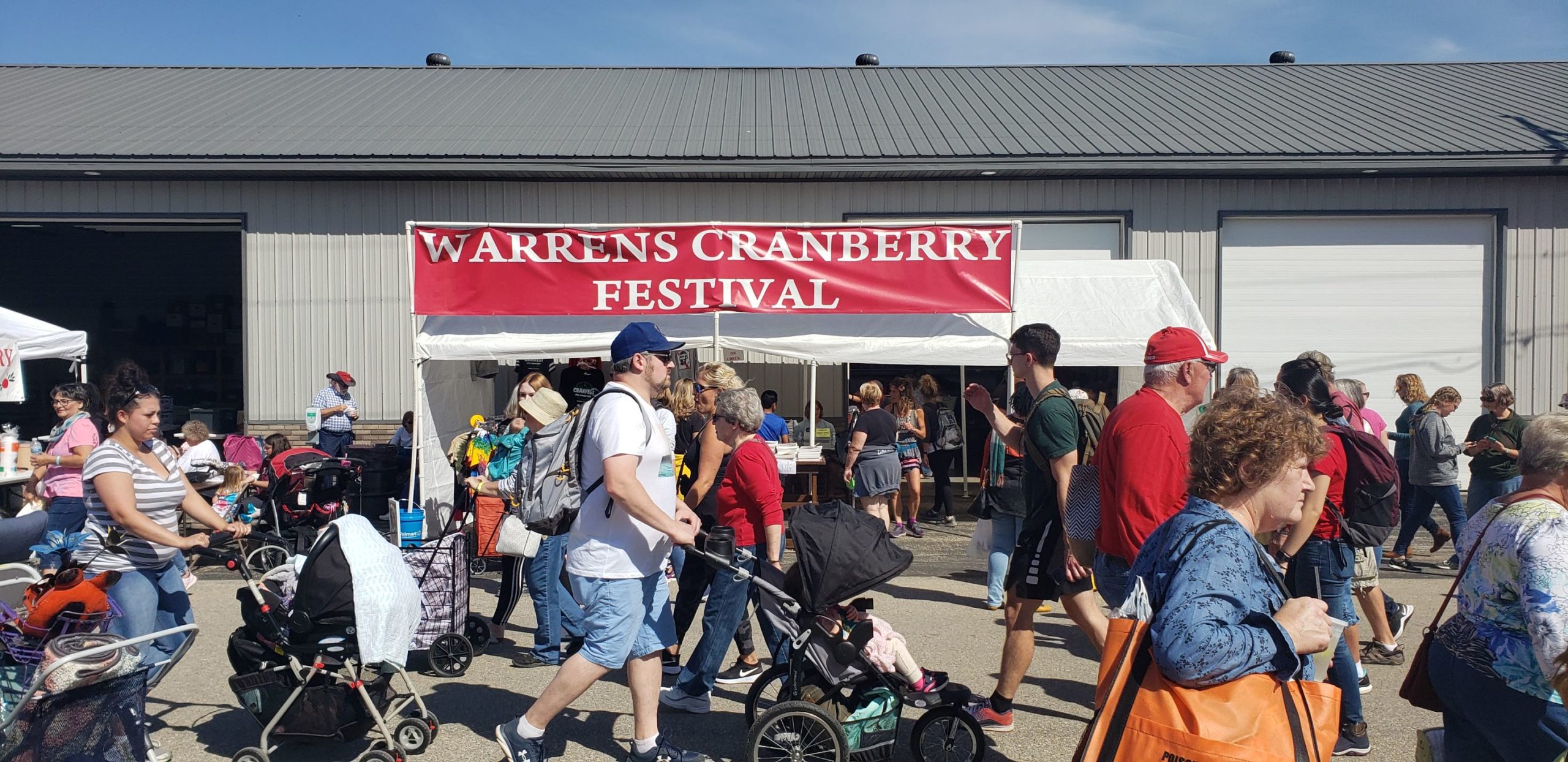Festivals in Africa, USA: An African journalist peeks into the Warren Cranberry Fest
A special feature by James Kokulo Fasuekoi|Editor-Publisher
Background
In the African French speaking nation of Guinea, the annual Kora-et-Cordes musical festival comes alive every December in Conakry. A second French-speaking neighbor, Côte d’Ivoire, hosts MASA (Market for African Performing Arts), one of Africa’s biggest cultural festivals, every two years that showcases the creativity of young folks of the continent. Hundreds from Europe, Africa and America gather in Abidjan to participate in MASA.
Nigeria, Africa’s main superpower nation stages multiple cultural festivals including the popular “Yams Festival” otherwise known as the “Harvest” each year. Its sister country Ghana runs perhaps the highest number of festivals in Africa annually, roughly anywhere from 70 to 90 traditional and cultural festivals with the “Homowo” and “Fetu Afahye” among the biggest.
For Liberia, the land that resettled freed Black American Slaves during the 1800s, had no festival as of the time of this article, a sad story indeed for a country in Africa with 16 indigenous groups, each with its distinct cultures and traditions. That’s partly because the last authoritarian regime of Sirleaf succeeded in shutting down cultural festivals previously staged by several ethnic groups including Gbandi, Kpelleh, Mandingo, Lorma and Kissi. As a result, Liberians are neither African nor American.

But Lormas of northern Liberia, together with their Guinea kinfolks seem determined to change that narrative this weekend with the first ever joint biggest festival that commences Saturday, Dec. 11 in Monrovia. Titled: “Lorma-Gie-Tia” (meaning: “We the Lorma People“), organizers say this is an entire week affair (Dec. 11-17). After launching ceremonies in Liberia’s capital hundreds of Lormas would then take a cross-country bus ride to Lofa County, their origin, and climax the event.
America’s many festivals
America, for the most part stages countless festivals-some come in the form of a trade fair throughout the year like Ghana. They even host the festival of knowledge which is called the Aspen Ideas Festival (AIF), held in Aspen, Colorado, in every June and attended by close to a thousand guests from around the world. Among the AIF guests and presenters, are former U.S. presidents, lawyers, scientists, journalists, writers, comedians and artists.
In all respects the AIF is very much like Guinea’s annual Kini Afrika otherwise called Festival des Arts de Conte which features or provides a platform for African authors, storytellers, journalists, poets and writers to exhibit their talents and works in general in an entertaining way. This could be better referred to as Africa’s AIF (Africa Ideas Festival)
The Midwest state of Wisconsin, the focus of this piece, is known for hosting some of America’s largest annual trade fairs and festivals. Its Corn festival for that matter is something many people in and out of state eagerly look forward to attending each year. Its main highlight is harvesting and eating butter-up corn while you shop in the heart of Wisconsin.

Next, is the Warren Cranberry Festival, the subject of this article, staged every September 24th in a small town called Warren also in Wisconsin.
Bus ride to the Cranberry Fest
Spiritual Life Church has for years bused many of its members as well as people from other churches to the festival every September. The trip is a two-hour smooth bus ride from the church’s Brooklyn Center’s compound to Warren, WI. Because of long walks all day, most people love to put on loose clothing and shoes for this event. Apart from their back pads containing some personal items, many make sure to take along plastic chairs for resting.
The buses or coaches as they called them look bigger than pre-war era Liberia’s “TATA” buses and consist of a small restroom, the size of the ones on Delta Airlines. The bus ride can be quite fun and comfortable and with breathtaking views that one can’t afford to miss especially if he or she is an ace photographer and holds deep connection to the landscape and nature as a whole.

On our last September journey, there were about 25 to 28 people aboard the coach, all of us Christian brothers and sisters including a couple of our senior pastors like Dr. Joe and Dr. Judy Fornara. As always folks had joined us from other churches in the city. SLC arranges these short and long trips in order to have its congregation interact with Christians from other churches. Ever since 2018 we went to Branson, Missouri, plus our 2019 Warren Cranberry Fest, I have been addicted to these trips-hence it grieved me that we couldn’t go in 2020 due to COVID.
Cranberry Festival is ‘world’s biggest’
By the time we arrived in Warren, WI, sales agents had already set up their booths along the main streets and were ready for business. There were thousands of “early birds” or shoppers out in the streets enjoying the festival just as we zoomed in. And instead find a way and get off the bus and joining the crowd, the festival tour-guide, a lady, redirected our coach, and took us to the end of town to show us a cranberry farm and how they do planting and harvest from the days of old till now in this region.

According to organizers of the Warren Cranberry Fest, theirs is so far the world’s largest and boasts of some 800 arts and crafts at each festival. This is in addition to 300 more flea market booths, 100 farm market booths as well as 100 food vendors. The shopping activities extend about three miles through the town’s main streets.
This year’s crowd could be around 45,000 people, a little more than 2019. The Warren festival undoubtedly keeps getting bigger every year and with new things being added on to attract more visitors across all of North America.

One gets amazed that residents of Warren never complained of the disruptive crowd that encroached upon their peace every year during the festival. Along the streets and at every street corner goods of all sorts-from fabrics to antiquity plus classical fine arts all compete for buyers. Parents carrying their kids in most cases conveniently use strollers or wagons to transport them along with purchased items. Some share lousy outfits with their children as a mark of identification so they won’t lose sight of them in the jammed crowd.

Streets are shut down completely to vehicles; this includes police cars. There are large open designated fields on the outskirts of town available to visitors for parking. But there’s an exception to EMS vehicles; they move everywhere and standby throughout the festivities, ready to move patients who may suffer exhaustion or get fainted, a scene quite common at this festival. The police use golf carts to maneuver their way through the human traffic.
Foods at the festival
The first thing one is likely to notice on arrival is the smell of grills, wafting through the air along the streets. It is so tempting that you find it hard to resist the taste of puffy hotdogs, burritos, not to mention those well-seasoned grilled lambs, wrapped in fresh onions, with wild green peppers.
And if you are someone who loves food and is willing to taste cuisines of other cultures, the Warren festival is just the right place to go. There are hundreds of different delicious meals available to choose from, of course, American and Mexican dishes; not African or Caribbean unfortunately.

Once you’ve collected your meals, check around and find the nearest square with benches and relax with your family to crunch on your lunch and listen to the sounds of Mexican, or Wild West jazz music in the background.
Cranberry products


One thing that keeps many hypnotized is the way the cranberry itself has been transformed or processed into a variety of products such as foods and non-food items. The edible items include cranberry honey jam, juices, maple syrups, cranberry pudding, cranberry ice cream, cranberry cakes, liquors, etc., on sale in booths. Among non-edibles are cranberry soaps and skin creams and this can get the hair of an African to rise and wonder as to what are Africans too doing with their coffee and cocoa especially in the year 2021?

Imagine West Africa must be the largest grower of coffee and cocoa and with the Ivory Coast as leader in world cocoa production. Yet, Africans don’t ever get to enjoy their own grown coffee products because there aren’t Starbucks or Caribou coffee shops like in the U.S. Nor do African children enjoy chocolate products for there isn’t a single factory as far as we know in the entire continent.
How strange, especially for a continent that ships a huge chunk of coffee and cocoa abroad seasonally but leaves nothing for its population to enjoy?
Unlike coffee that grows on taller trees, cranberries normally spread out on land beneath the knee level and they plant them much the same way people plant swamp rice in Liberia or Africa by cultivating the swampland. Wisconsin, trademarked as America’s Dairyland, is the nation’s largest cranberry growing state.
Festival performances

One of the fun parts at the festival people love to watch is the show put up by young college grads and students. They usually start with a marching band to open the festival, followed by a group dance every other hour or so. It is fun to watch those folks do their festival dance. The dance is normally complimented by the appearance of a top U.S. Hollywood star allowed to offer remarks at the opening ceremony.
Antiques at the festival
The Warren Cranberry Fest is a place where anything goes! Every arts type that one could think of in the world can be found at this festival. From wood carving to other types of visual arts, including fine arts and junk arts are sold here. Among the carving, the bears, eagles and tortoises are the most popular features while the junk arts usually consist of old rusty items from barns such as valises, tool boxes, buckets, animal traps, bottles, water jars, diggers and shovels.

Most junk arts are made of hewed wires that artisans have crafted with smaller jars or bottles that appear like bugs and butterflies and cost not less than $25.00 each in some cases. For those who admire this art form, the beautifully made corn style might be one of the best to add to their collections, come next year’s festival.

Seeing the junk arts, I thought about our old buckets, animal traps and drinking cups that we abandoned on our farms or in the village nearly 45 years ago which, if recovered, could bring a fortune to my family.
In the advanced world such as the United States, they are termed “antiques” and their demand increases with the passage of time and the more they become expensive and people buy them to preserve the past.

Unfortunately, in Africa, particularly Liberia, people would think you have a mental issue if you were to do such collections and put them out for sale at a fair or festivals. Reading this piece may perhaps help some to change such a mentality!
Gospel and the ‘Strange doctrine’
While on our shopping spree I ran into a couple believed to be Christians who held signs urging people to “repent.” The lady’s sign read: “SEEK GOD’S KINGDOM REPENT.” The other displayed by her husband said: “DONTPERISH.com.” “FOLLOW JESUS NOT THE CULTURE REPENT.”

“Follow Jesus not the culture repent” seemed somewhat vague and it aroused my curiosity, prompting me to stop. For the Bible in 1 John 4 states “Beloved, do not believe every spirit, but test the spirits to see whether they are from God, for many false prophets have gone out into the world.”
When he realized that I showed an interest in his preaching, the man rambled more like a Doomsdays soothsayer in the market place and would not give me a chance to speak.
When my wife, Martha who had been walking along with me returned quietly, held my hand to leave, he seemed agitated. “Oh oh…who is she, and who called you here? the man said, referring to Martha.
“She’s my wife,” I replied. “Why even speak when men are talking?” he erupted again. “First of all your head isn’t covered…You ought to cover your body from head to toes and wait till permitted before you talk” he resorted.

Before I could say a word he announced: “Look at my wife”, as he waved his hand towards the lady that stood a few yards away wearing a scarf with a dark sunshade.
By then I had had enough and we walked out of there. I don’t wish to be a “judgmental” Christian but from his talking I discerned he serves a different God other than Christ Jesus!
I wonder, with such “doctrine” and anger he carries around how possibly he could even convert anyone to follow his “god” as true Christians don’t behave in such a manner in the first place. For he seems to practice those very ideas (the law) that he was preaching against, ‘don’t follow culture.’ Yet he demanded a Christian woman to dress to his liking at a crowded flea market. Not only that, but he also teaches that a woman ought to remain silent when men are talking. How interesting!
Mind you, he had a tiny camera mounted to his chest-the type on the helmets used by mountain bikers to capture spectacular video footage. His wife too had one secured to the signpost she held unto and recording moment by moment interaction with passersby. I knew it from being a skilled photographer for over 25 years. How creepy that seems when the primary concern of a Christian should be about converting sinners to the Lord?

The Fivefold Ministry
Few yards away from where the couple stood, sat a man who played a guitar. He was sandwiched by various signposts but his consisted of the Fivefold Ministries gifts or office, called Christ found in Ephesians 4:11: Apostles, Prophets, Evangelists, Pastors and Teachers and with Jesus as the head.
Here, the atmosphere looked totally different and one could sense the Spirit of God being around just by the Word and that made a great difference.
Looking upon my not-so-good encounter with the couple earlier, I confess it was completely a mistake on my part to stop and listen to the man’s weird preaching when my wife Martha and our senior pastors, walking ahead of me had passed by without even staring at them.
Overall, our trip was fruitful and I considered numerous possibilities in terms of what my country of origin could do with its abundant seasonal harvested coffee plus cocoa produced by northerners in Lofa. Maybe we could build a small Hershey like the one near Kutztown in Pennsylvania and supply the rest of Africa with chocolate of all types.
If that doesn’t seem to work I could perhaps return to my childhood village in Yeala, fetch out those old buckets, jars, 1930s designed bottles, and utensils buried there underground to be sold on this extensive American antique market for some good bucks.
Better still, we could put up a harvest festival in Liberia during the rice, corn, cocoa and coffee harvest-seasons and showcase locally made products and invite our cousins from neighboring Sierra Leone, Guinea and La Côte d’Ivoire to join us.
ALL PHOTOS BY JAMES KOKULO FASUEKOI
JESUS CHRIST IS COMING SOON! ARE YOU READY?











